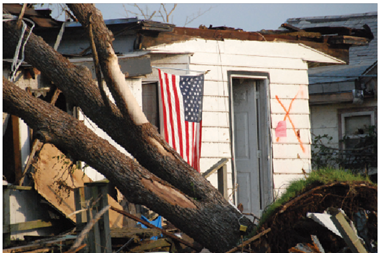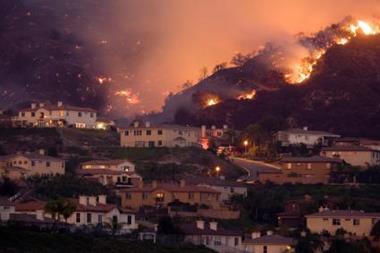2009 was a relatively mild year for natural catastrophes, with losses well below average. But with the tragedy in Haiti in January, and rising global temperatures continuing to put certain regions under pressure, there is no cause for complacency, argues Nathan Skinner
Anyone living in Britain this winter will understand that climate forecasting is an inexact science. Despite a long term forecast that predicted one of the warmest winters on record the UK economy was virtually shut down by snow and ice in January. Businesses, homes, shops and schools all got snowed in after icy Siberian winds swept over the British Isles sending them into a deep freeze. Instead of being one of the warmest it was the coldest winter in a hundred years, reports claimed.
Predicting the impact of natural catastrophes is equally fraught with problems. While it’s impossible to decipher any trends from a single year, a look back at last year’s most devastating natural disasters provides some degree of insight into what to expect and may help businesses prepare for catastrophic events in the future.
The first decade of the millennium ended with a relatively mild year of catastrophe size events. This, combined with a tailing off of the financial crisis, helped insurers rebuild their balance sheets. And it exerted a downward pressure on prices in the catastrophe insurance market.
Proving that Mother Nature is full of surprises last year’s calm was shattered in January when a massive magnitude seven quake demolished the Caribbean island of Haiti. Horrifyingly, some parts of the island, including bits of the capital Port-au-Prince, were totally leveled. At the time of writing it was feared the death toll might rise as high as 200,000 (see box for more details).
Focusing here on the events of last year, the scale of tragedy was fairly typical, whilst insured losses remained low. Reinsurance broker Aon Benfield observed 222 natural catastrophes in 2009, adding that this was in line with the previous two years. Munich Re’s depiction of 850 catastrophe events in 2009 was just above its long term average of 770 events per year. While the characterisation of events differs, both assessments are in broad agreement that last year presented nothing out of the ordinary.
Economic losses, however, were considerably lower than they have been in previous years. The rate of loss varies a little depending on whom you trust. Compared with economic losses as a result of natural disasters of around $200bn in 2008, last year saw a total loss of around $50bn (Munich Re), $52bn (Swiss Re) or $58bn (Aon Benfield). Around 10,000 people lost their lives to natural disasters in 2009, according to Munich Re, well below the long term average of 75,000. Haiti’s devastating earthquake means 2010’s death toll is already set to exceed the average. 2005 remains the costliest year for natural catastrophes with Hurricane Katrina accounting for insured losses alone of $45.5bn.
Aon reports that no single insured loss event occurred above $5bn in 2009. But this is no reason to be complacent, warns Professor Peter Höppe, head of Munich Re’s Geo Risks Research: "Make no mistake: despite the lack of severe hurricanes and other mega catastrophes, there was a large number of moderately severe natural catastrophes.”
Nature of threat
Last year provided frequent reminders of the risks posed by earthquakes. It was Asia that suffered the most when two massive earthquakes struck Indonesia and the Samoa region in the space of a day in September. A series of magnitude eight quakes in the South Pacific, causing huge tsunamis, cost the lives of around 1,100 people and left 500,000 people homeless, according to Guy Carpenter’s 2009 Catastrophe Update. The Pacific Tsunami Warning Centre said three waves of up to 46 feet (14 meters) smashed into the low-lying Samoa islands, wiping out whole villages. Insured losses were not significant, because of the low take up of insurance in the region.
In April 300 lives were lost when the deadliest quake in 30 years struck Italy. The magnitude six quake occurred in the Abruzzo region. Officials said 15,000 buildings were damaged or destroyed, 10,000 in the town of L’Aquila, which gave the disaster its name. Munich Re estimated the economic damage at around $2.5bn.
Another major disaster hit the headlines in February when vicious wildfires killed more than 200 people in the Australian state of Victoria and left 7,500 people homeless. Fuelled by hot dry conditions and northerly winds the bushfires destroyed entire towns, mainly located in the east and southeast of Melbourne. The record heat wave that caused the fires prompted environmentalists to call for tougher climate change restriction targets. Australia’s dry climate makes it particularly vulnerable to an increase in global temperatures. And with very few water reserves the country is also prone to severe drought.
Severe weather
Compared with the 25 year average, 2009 was a quiet year for hurricanes. There were nine named Atlantic storms and only three of these matured into hurricanes, none of which made landfall in the US, according to Aon. The mild season enabled insurers to recover a little from the heavy losses caused by hurricanes Ike and Gustav in 2008. The prospect of a hurricane making landfall in the south east of the United States in 2010 is higher than normal, while Florida and the Gulf are at a reduced risk, predicted Guy Carp. In contrast to the Atlantic season, the Eastern Pacific saw 20 named storms last year, 25% higher than the long term average, with five major hurricanes, only one of which, Jimena, made landfall in Mexico where it quickly weakened to a category one storm.
Despite the relative calm, severe weather accounted for around 45% of global insured losses in 2009. The three biggest events to cause losses of more than $1bn in 2009 were related to Windstorm Klaus, summer hailstorms in Europe and severe tornadoes in the US - although the approximately 1,000 tornadoes that formed in the US last year is just below the 25 year average.
In contrast to the US, Europe looked severely weather worn at the end of the year, suffering above average weather related losses in 2009. Windstorm Klaus was responsible for much of this, when it hit France and Spain with hurricane-force winds in January. Klaus caused economic losses of around $6bn, according to Aon. Wind gusts of up to 195 kmph left a trail of destruction and 25 people dead. The storm was the most powerful to hit France since Windstorm Martin in 1999.
Severe hailstorms in Switzerland, Austria, Poland and the Czech Republic, in July, caused insured losses of around $1.25bn, according to Guy Carp. Switzerland was particularly badly affected by the damage caused by hailstones the size of golf balls. Heavy weather and tornadoes in the southern and Midwestern regions of the US between February and June triggered insured losses of well over $3bn, added Guy Carp.
Impact on insurance
A relatively swift recovery of the insurance market following the financial crisis, coupled with low catastrophe losses in 2009, resulted in ample supply and competitive prices for property catastrophe lines, reported Guy Carp in its reinsurance renewals briefing at the beginning of this year. Prices across most reinsurance lines declined in January, a good sign that the direct insurance market could respond positively as well.
Catastrophe prices in the US were down between 6% and 11%, while in Europe they remained flat to 5% lower, according to the January renewals index. The effect of Klaus was to increase prices in France by 10% and between 20% and 30% in Austria. UK property catastrophe prices declined by 5% to 10%. Eighteen new catastrophe bonds appeared on the market in 2009, exceeding the 10 issued in 2008 - suggesting that there should be at least some capacity for mega catastrophe risks.
Property insurance prices remained stable at the January renewals, falling less than half of a percentage point, according to the US based Risk and Insurance Management Society’s (RIMS) pricing index. “Capacity is abundant in almost every line of insurance. As things now stand, there is little reason to expect commercial insurance prices to increase in the near future. More likely, they will fall yet further,” says Daniel Kugler, a member of RIMS and assistant treasurer, risk management, at Snap-on, Inc.
Future trends
Last year was the fifth warmest year on record and the 32nd consecutive year of above normal global temperatures, according to Aon. Some say that climate catastrophes have risen in direct proportion to these global temperature increases over the last several years. But there is still considerable debate over whether climate change is causing an unusual increase in severe weather events.
Munich Re’s Höppe believes there is a noticeable trend towards an increase in weather related catastrophes. He notes the increase in weather related losses in the US since 1980 to the present from an average of $4bn per year to $10bn (see also chart). "Initial analyses indicate that, apart from socio-economic factors, this is already due in part to climate change", he says.
Torsten Jeworrek, the Munich Re Board member responsible for global reinsurance business, adds that major weather-related natural catastrophes worldwide since 1950 have tripled. “In the light of these facts, it is very disappointing that no breakthrough was achieved at the Copenhagen climate summit in December 2009,” says Höppe. "We need as soon as possible an agreement that significantly reduces greenhouse gas emissions because the climate reacts slowly and what we fail to do now will have a bearing for decades to come."
Haiti earthquake
Box out: Haiti earthquake
The Haiti disaster is the worst humanitarian crisis to face the world since 2008’s Sichuan earthquake or the 2005 Boxing Day Tsunami in South East Asia. The quake overshadowed anything seen in 2009 and provided a chilling reminder of Mother Nature’s unpredictability.
Just before 10pm on January 12 a powerful magnitude seven quake struck the impoverished Caribbean nation. At the time of writing the quake was feared to have killed 200,000 people, according to worst case estimates. The European Union said it had left 250,000 injured and made 1.5m homeless. The initial quake was followed by around 50 aftershocks the worst of which, to date, occurred on January 19 at about 6am.
The initial quake was located 25 kilometres southwest of Port-au-Prince, the island nation’s capital, and about 13 kilometres underground, according to the US Geological Survey. It was felt in neighbouring Dominican Republic and Eastern Cuba. It is the largest quake to hit Haiti for around 200 years.
The aftermath of the disaster was described as catastrophic by officials. A helicopter assessment found that some areas had suffered almost total destruction. Heavily damaged buildings included the presidential palace, parliament, the five-story United Nations (UN) headquarters and World Bank offices. About a third of Haiti’s population, 3m people, have been affected by the disaster, said the Red Cross. The UN said it was the worst disaster it has ever confronted.
A week after the quake thousands of people were still too scared to return indoors and decided to sleep outside amid fear of more aftershocks. Aftershocks can sometimes go on for months as the earth adjusts to the new stresses caused by the original quake.
Communications to some parts of the island were completely cut off by rubble and corpses, making the aid relief programme more difficult. Port-au-Prince’s airport quickly became congested with flights and the port, badly damaged during the quake, was desperately in need of repair. Riots and looting broke out in the city as frustration and lack of food and water boiled over into violence.
Source: Reuters, BBC, UN, EU, Guy Carpenter Catastrophe report
Postscript
Nathan Skinner is associate editor, StrategicRISK




















No comments yet